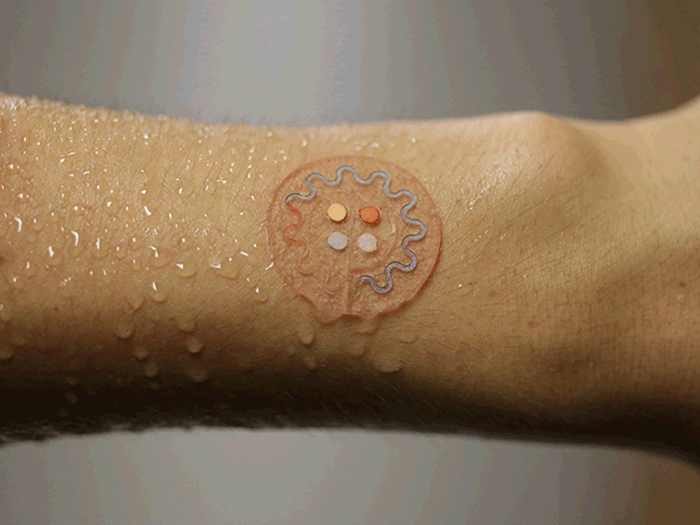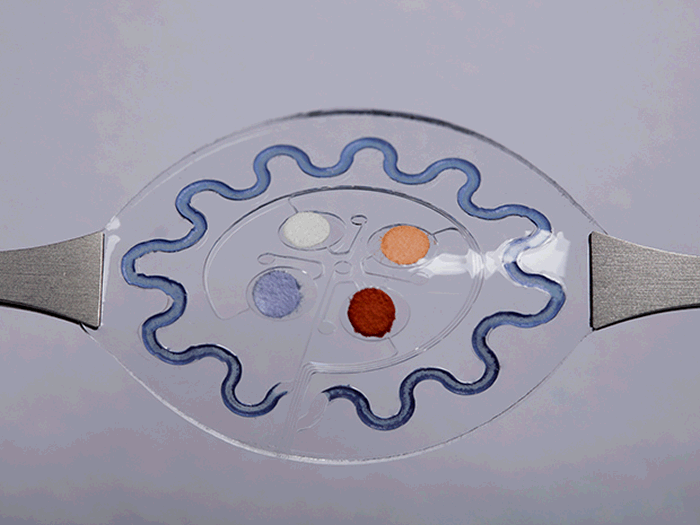Sweat could be the next thing wearable devices sense to track your health, researchers say. A new microfluidic skin patch capable of collecting and analyzing sweat has survived tests that included a grueling 104km bike race. And the next gen wearable device has attracted the attention of companies such as cosmetics giant L’Oreal and a major sports beverage maker—not to mention the US military. It could even pave the way for a painfree, bloodless method of prescreening people for diabetes in the future, according to its inventors.
The flexible sweat sensor collects sweat in a tiny tubing system as it’s worn against the skin. Different sections of the sensor slowly change color as they react to different levels of certain chemicals found within sweat. Any smartphone with the right app can take a picture of the sweat sensor to automatically interpret the color changes and biochemistry of the sweat as certain health signs. To tests the device’s ruggedness, volunteers even wore the sweat sensor during a long-distance, outdoor bicycling race.
“This is radically different from current-generation wearable devices that are a block of electronics strapped to the body,” says John Rogers, a physical chemist and materials scientist at the University of Illinois at Urbana-Champaign. “This allows a clinical-like precision measurement of health markers that physicians know how to interpret.”
Rogers’ group has previously developed soft electronics such as flexible, dissolvable brain implants. In this case, they minimized the use of electronics in the skin patch to ensure that it could be resilient and cheap enough for one-time use. The details on their work with an international team of South Korean and Chinese collaborators appeared last week in the online edition of the journal Science Translational Medicine.
The biggest challenge in making the sweat sensor was balancing the softness, thinness, flexibility and comfort of the device with its functionality as a health sensor, Rogers explains. The researchers ensured that the device could create a water-tight seal with the surface of the skin so that it could remain in place during even the most high-intensity exercise.
But they also needed to figure out how to make a functional sensor without relying on either cheap but rigid electronics or more expensive, flexible electronics. Their solution was to use a microfluidic system of tiny tubes to channel the sweat toward different absorbent sections capable of chemically reacting to the presence of the different sweat components.
By comparison, today’s athletic research facilities currently use absorbent pads or paper and bulky benchtop lab equipment to collect and analyze sweat.
“Our device uses microfluidic, lab-on-a-chip type approaches in sweat capture and analysis, and simple colorimetric chemistries for detection,” Rogers says. “Much different than previous approaches that rely on less sophisticated fluid capture schemes and more expensive electronic-based readout schemes.”
The readings collected by the sweat sensor seemed comparable to the current lab-based standards during a trial involving nine volunteers doing indoor cycling. Health readings included sweat rate and sweat loss, pH (an indicator of hydration levels), and concentrations of lactate, glucose, and chloride.
A separate trial tested the sweat sensor’s ability to hold up during a 104km bike race called the El Tour de Tucson. Marvin Slepian, an interventional cardiologist at the University of Arizona in Tucson who worked with Rogers’ team, enlisted the help of several cyclist friends—a total of 12 healthy volunteers—to carry out the outdoor trial. The resiliency of the devices under such tough conditions was a testament to the flexibility and ruggedness of the microfluidic tube system, which had been extensively modeled by research collaborators at Northwestern University in Illinois and Zhejiang University in China.
The sweat sensor can hold captured sweat for about 125 hours after being peeled off the skin as long as all the sensor channel openings are sealed. Even with open channels, the captured sweat remains for about 75 hours after removal from the skin.
Rogers and his collaborators believe it’s possible to eventually turn the experimental sweat sensor into cheap, disposable commercial devices. The disposable or recyclable design avoids complications such as cleaning and possible contamination during reuse. Their current goal is to make the sweat sensor into a device costing just $1 or $2.
Sweat sensors gets truly exciting when imagining the medical possibilites. Rogers’ lab has been in talks with a biomedical company about how such sweat sensors could eventually enable bloodless prescreening for diabetes. But first, the researchers need to boost the sensitivity range of the glucose sensing and nail down the correlation between glucose in sweat and in blood.
But even the current generation of flexible sweat sensors holds much promise for many different companies. L’Oreal, for example, played a large role in organizing and funding this particular study. The company is interested in using the sweat sensors to replace the bulkier research tools for understanding sweat chemistry and odor so it can develop new products. “As a cosmetics company, they’re basically a skin company when you think about it,” Rogers says.
Rogers’ lab has also been conducting additional exercise and physiology studies with an unnamed sports beverage company. And the US Air Force has gotten on board with testing more advanced versions of the sweat sensors as worn by active-duty airmen at the Wright-Patterson Air Force Base near Dayton, Ohio.
The researchers have already developed and begun testing several different versions of sweat sensors beyond the one described last week; a consequence of the time lag between publishing research results and making progress in the lab. “At this point we’re two or three steps beyond what is being reported in this paper,” Rogers says.
More information: IEEE Spectrum



Comments are closed, but trackbacks and pingbacks are open.